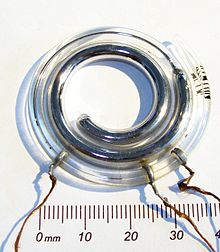Contact thermometer

Contact thermometer are mercury - liquid thermometers , the means projects into the mercury column of electrical contacts as a temperature switch are formed.
In the past, contact thermometers were often a component of temperature regulators or monitors and can switch small loads (e.g. an aquarium heater , now replaced by a rod heater , or about 0.1 amps at 230 volts AC) directly. To switch larger loads, they were often combined with switching amplifiers, e.g. B. supplemented with a thermal mercury switch . The service life or the permissible number of switching operations increase as the electrical switching load of the contact thermometer decreases. This means that> 10 6 switching operations can be achieved at a voltage of 300 V and a switching capacity of 0.15 VA. Under pressure and in quartz glass, some of these could be used up to 700 ° C.
Contact thermometers were manufactured for fixed or adjustable switching temperatures. For fixed temperatures, two wires are fused into the glass of the capillary as contacts . For adjustable temperatures, the top of the wires protrudes into the capillary from above and can be adjusted using a spindle drive housed in the hermetically sealed glass housing. The adjustment is made from the outside by a rotating permanent magnet, whose field acts like a magnetic coupling through the glass. In 1926, the Juchheim company from Ilmenau applied for a patent for the first glass contact thermometer, with which variable temperature settings were possible using adjustable metal threads.
Today contact thermometers have been replaced by electronic temperature sensors and controllers. In the case of low demands, temperature switches , etc. a. with bimetals an alternative.
Disadvantages of contact thermometers are their fragility and the mercury they contain. Advantages are the visual recognizability of the actual and switching temperature as well as the very precise switching point compared to other energy-free temperature switches, which is only slightly affected by hysteresis.
Individual evidence
- ↑ a b Dieter Geschke et al .: Physical internship . Springer-Verlag, 2013, ISBN 978-3-322-97619-2 , pp. 105 ( limited preview in Google Book search).
- ↑ Carl Woytacek: Textbook of glass blowing including the production of hydrometers, barometers, thermometers, measurement analytical devices, vacuum tubes and mercury air pumps With instructions for measuring the vacuum, the mercury vapor lamps, adjusting the instruments, working on the high vacuum pump and treating the mercury . Springer-Verlag, 2013, ISBN 978-3-662-34531-3 ( limited preview in Google book search).
- ↑ Frank Bernhard: Technical temperature measurement, physical and metrological fundamentals, sensors and measurement methods, measurement errors and calibration . Springer-Verlag, 2013, ISBN 978-3-642-18895-4 , pp. 547 ( limited preview in Google Book search).
- ↑ Measurement technology . F. Vieweg, 1906, OCLC 312924635 , p. 116 ( limited preview in Google Book search).
- ↑ a b Georg Leuchteiner, Walter Mangoldt: Handbook of control engineering . Springer-Verlag, 2013, ISBN 978-3-642-52750-0 , pp. 160 ( limited preview in Google Book Search).
- ↑ Houben-Weyl Methods of Organic Chemistry Vol. I / 2, 4th Edition General Laboratory Practice 1 . Georg Thieme Verlag, 2014, ISBN 3-13-179634-0 , p. 703 ( limited preview in Google Book search).
- ^ A b Rüdiger Kramme: Medical technology - procedures - systems - information processing . Springer-Verlag, 2016, ISBN 978-3-662-48771-6 , pp. 733 ( limited preview in Google Book search).
- ↑ and monitoring methods as a basis ...: Measurement in the application of energy Measurement and monitoring methods as a basis for the rational use of energy . Springer-Verlag, 2013, ISBN 978-3-642-93395-0 , pp. 97 ( limited preview in Google Book search).

